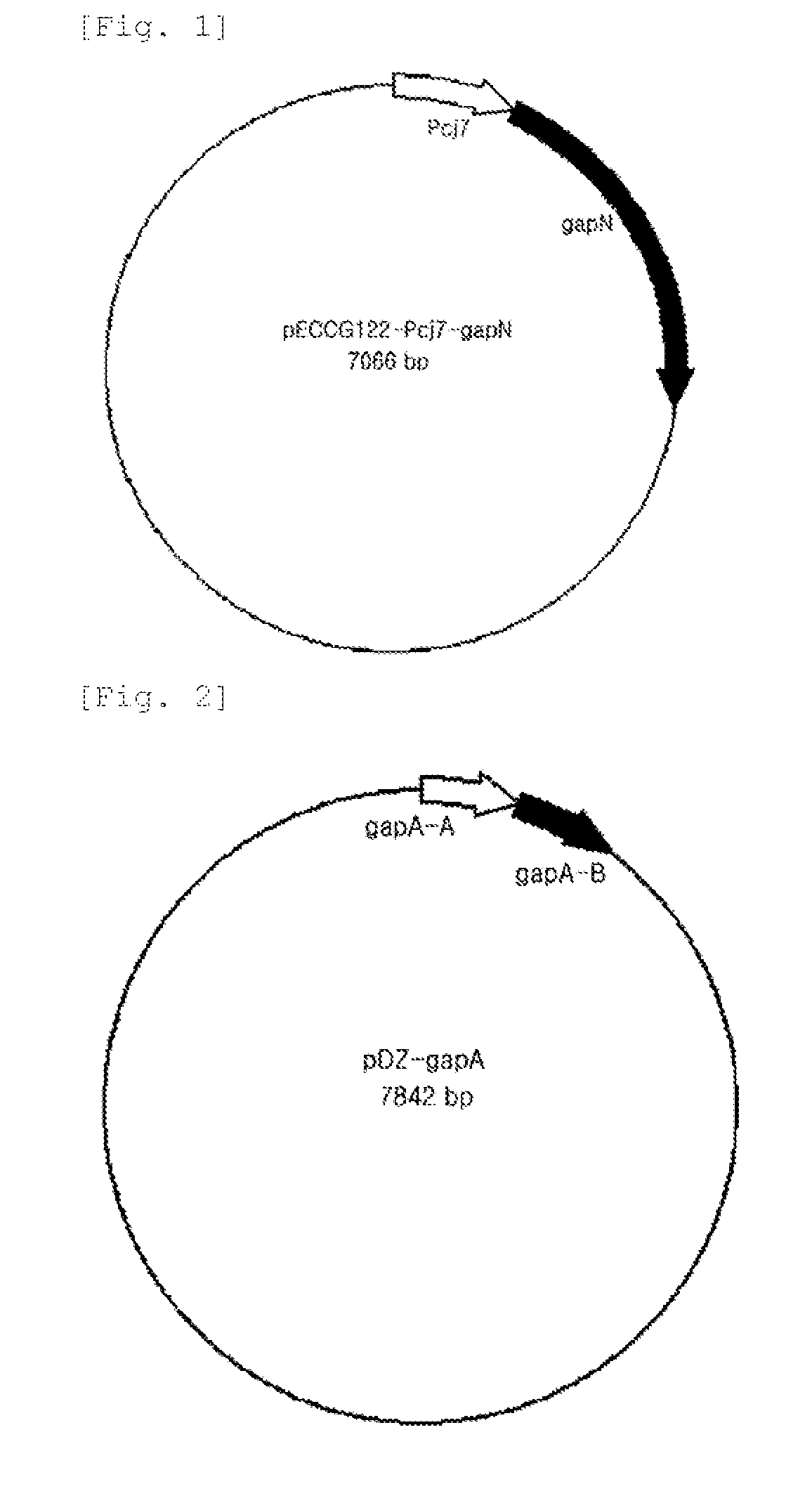Method for producing l-lysine using corynebacterium sp. that has obtained the activity of glyceraldehyde-3-phosphate dehydrogenase derived from an alien species
a technology of lysine and lysine, which is applied in the field of producing llysine using, can solve the problems of unsatisfactory results and achieve the effect of improving the productivity of l-lysin
- Summary
- Abstract
- Description
- Claims
- Application Information
AI Technical Summary
Benefits of technology
Problems solved by technology
Method used
Image
Examples
example 1
Exploration and Cloning of gapN Gene of Streptococcus mutans
[0037]The sequence of the Streptococcus-derived gapN gene has been clearly revealed. The gapN gene information of Streptococcus mutans (accession No. NC—004350) was acquired from NIH GenBank. Based on the reported sequence, a pair of primers described in the following Table 1 was synthesized and 1428 base pairs of the gapN gene were amplified by Polymerization Chain Reaction (PCR) [Sambrook et al, Molecular Cloning, a Laboratory Manual (1989), Cold Spring Harbor Laboratories](PCR conditions: Denaturing=94° C., 30 sec / Annealing=50° C., 30 sec / Polymerization=72° C., 1 min 30 sec, 30 cycles) using a chromosomal DNA of the Streptococcus mutans ATCC25175 strain as a template, and cloned into an E. coli plasmid pCR2.1 using a TOPO Cloning Kit (Invitrogen) so as to obtain a pCR-gapN1 plasmid.
TABLE 1PrimerSEQ ID PrimersequenceNO.gapN_F15′-GCG CAT ATG ACA AAA CAA TAT 1AA AAA-3′gapN_R15′-GCG TCT AGA TTA TTT GAT ATC 2AAA TAC-3′
example 2
Construction of gapN Expression Vector
[0038]The gapN gene-containing pCR-gapN1 vector obtained in Example 1 was cleaved using restriction enzymes Nde-I and Xba-I, and the gapN-encoding gene fragment was only separated, and an expression promoter Pcj7 (reference; Patent Publication No. 2006-0068505) was ligated with a shuttle vector pECCG122 of E. coli and Corynebacterium (reference; Patent Publication No. 1992-0000933), so as to construct pECCG122-Pcj7-gapN1 (FIG. 1).
example 3
Exploration and Cloning of gapN Gene of Streptococcus agalactie
[0039]The sequence of the Streptococcus-derived gapN gene has been clearly revealed. The gapN gene information of Streptococcus agalactie (accession No. NC—004116) was acquired from NIH GenBank. Based on the reported sequence, a pair of primers described in the following Table 2 was synthesized and 1428 base pairs of the gapN gene were amplified by Polymerization Chain Reaction (PCR) [Sambrook et al, Molecular Cloning, a Laboratory Manual (1989), Cold Spring Harbor Laboratories](PCR conditions: Denaturing=94° C., 30 sec / Annealing=50° C., 30 sec / Polymerization=72° C., 1 min 30 sec, 30 cycles) using a chromosomal DNA of the Streptococcus agalactie ATCC BAA-611 strain as a template, and cloned into an E. coli plasmid pCR2.1 using a TOPO Cloning Kit (Invitrogen) so as to obtain a pCR-gapN2 plasmid.
TABLE 2PrimerSEQID PrimersequenceNO.gapN_F25′-GCG CAT ATG ACA AAA GAA TAT 3CAA-3′gapN_R25′-GCG TCT AGA CTA TTT CAT ATC AAA4AAC-3...
PUM
| Property | Measurement | Unit |
|---|---|---|
| temperature | aaaaa | aaaaa |
| temperature | aaaaa | aaaaa |
| concentration | aaaaa | aaaaa |
Abstract
Description
Claims
Application Information
 Login to View More
Login to View More - R&D
- Intellectual Property
- Life Sciences
- Materials
- Tech Scout
- Unparalleled Data Quality
- Higher Quality Content
- 60% Fewer Hallucinations
Browse by: Latest US Patents, China's latest patents, Technical Efficacy Thesaurus, Application Domain, Technology Topic, Popular Technical Reports.
© 2025 PatSnap. All rights reserved.Legal|Privacy policy|Modern Slavery Act Transparency Statement|Sitemap|About US| Contact US: help@patsnap.com

